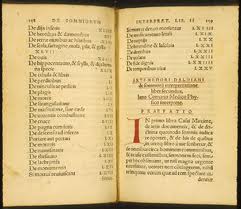Dreams and Dreamwork in the Roman period
That dreams were very important in Roman times can be seen from the fact that Hannibal's campaign against Rome was instigated by a dream (Woods & Greenhouse, 1974, p. 41). There were others, however, who attempted a more dispassionate view. Van de Castle mentioned Lucretius (98 to 55 B.C.) in this regard and also pointed out that Cicero (104 - 8 B.C.) was very cynical about dream interpretation, especially in terms of their predictive value. It seems that Cicero found examples in which dream interpreters came to contradictory opinions based on the same dreams and summed up his opinion by saying, "Even if true interpretations of dreams could exist, it is certainly not in the possession of those who profess it, for these people are the lowest and most ignorant of the people" (Woods & Greenhouse, 1947, p. 199).
No account of the Roman period would be complete without the mention of the five volume manual of dream interpretation by Artemidorus of Daldis called the Oneirocritica ("dream interpretation"), written in the second century A.D. As an indication of its popularity, a Greek edition was published in Venice in 1518, a Latin version appeared in 1539 (Basel), and in French (Lyon) in 1546. The first English edition came out in 1644 and over the next century, ran to 24 editions (Parker & Parker, 1985, p. 15) (A modern version, translated by Robert White and available in the Jung Institute library, appeared in 1975.). Van de Castle said that "it is the only surviving complete text from the twenty-seven books mentioned in antiquity. Its scope is enormous and covers practically every domain of dreaming as a psychological experience" (Van de Castle, 1994, p. 69).
In Our Dreaming Mind, Van de Castle included a review of the Oneirocritica as well as an appraisal of it, which is too long to include here, but a few "gems" might be worth mentioning. In unit 52 of Book 1, Artemidorus said "All tools that cut and divide things in half signify disagreements, factions, and injuries ... Tools that smooth out surfaces predict an end to enmities." In unit 68 of Book 2, having to do with flying, he went on to opine, "But it is best of all to fly at will ... and to stop at will for it foretells great ease and skill in one's business affairs" (Van de Castle, 1994, p. 67).
According to Van de Castle, Book 4 of the Oneirocritica "deals primarily with suggestions to his son with regard to his role as a dream interpreter." He wrote that, "It also serves as a sort of 'how to' manual on techniques of interpretation. The dream interpreter needs to know 'the dreamer's identity, occupation, birth, financial status, state of health and age' and to 'examine closely the habits' of the dreamer. The interpreter 'should learn local customs and the peculiarities of every place,' so that interpretations can be in accordance with them. Every detail of the dream, and how the dreamer felt about each detail, should be ascertained. The internal structure of the dream also must be evaluated to determine if the events were plausible or bizarre, appropriately interconnected, and customary for the dreamer. Before offering any interpretation, Artemidorus advised his son: 'You must consider the systematized totality of the dream images'" (Van de Castle, 1994, p. 68), advice that I can only echo and fully agree with.
Previous section Next section List of sections List of chapters

